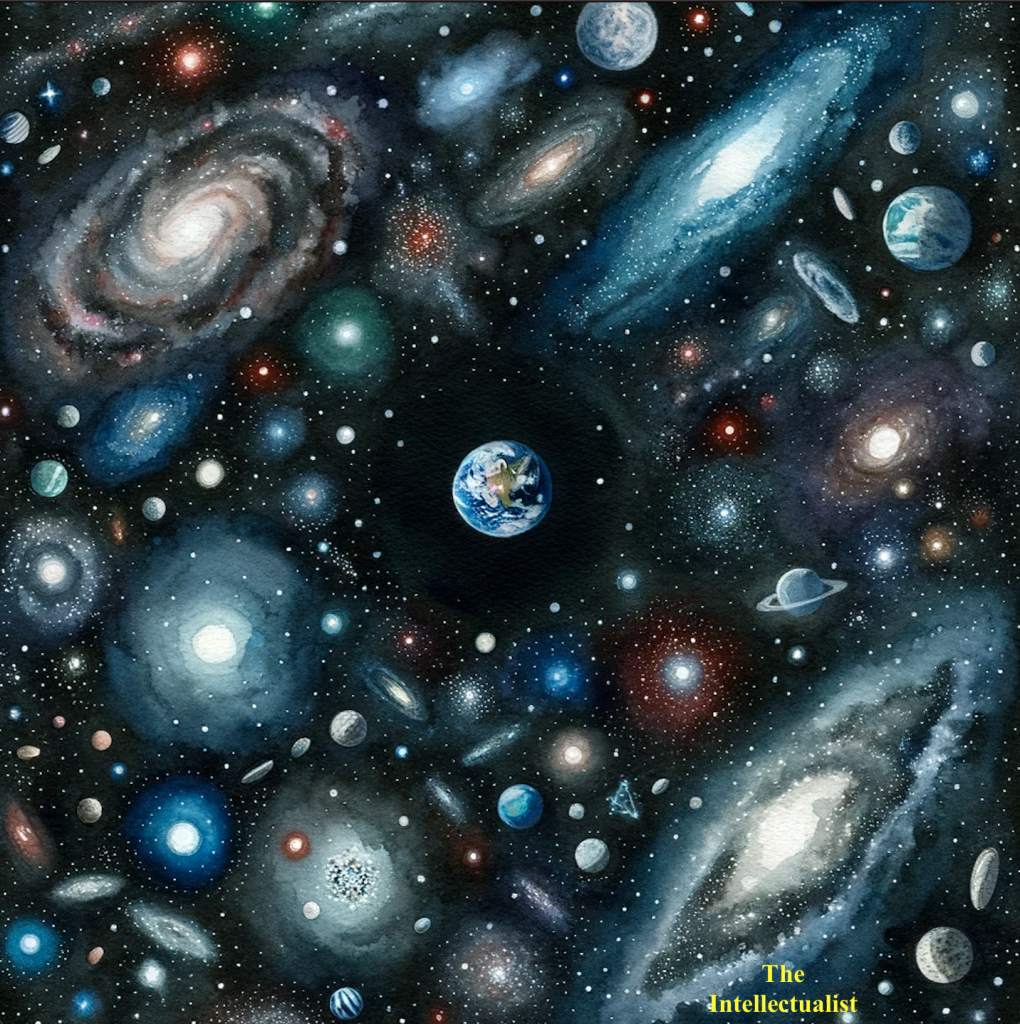The Pale Blue Dot: The Earth In A Nearly-Limitless Universe

The vastness of the universe is a concept that continually challenges the human imagination. The cosmic scales on which celestial bodies operate is beyond ordinary comprehension.
Yet, amidst this boundless cosmic theatre, lies a tiny, pale blue dot, our home, the Earth. The renowned astronomer Carl Sagan eloquently encapsulated this idea in his 1994 book, “Pale Blue Dot”, urging humanity to recognize the profound reality of our existence in the cosmos.
The Solar Neighborhood: A Speck in the Cosmic Scheme
Our celestial journey begins in our solar system, a minuscule fragment of the universe. The Sun, a medium-sized star, forms the nucleus of our solar system, around which eight planets, numerous moons, and a myriad of other celestial bodies orbit.
Even within this microscopic solar arrangement, the distances are vast. For instance, light from the Sun takes about 8.3 minutes to reach Earth, and over four hours to reach Neptune, the farthest planet from the Sun The solar system’s diameter is about 9.09 billion kilometers, a figure that barely registers on the cosmic scale but is monumental when considered from our terrestrial perspective.
The Milky Way: Our Galactic Abode
Zooming out, our solar system is but a fleeting speck in the sprawling Milky Way galaxy, which itself spans about 200,000 light-years across. The time it takes for light to travel from one end of our galaxy to the other is a staggering 100,000 years.
The Milky Way is home to about 200 billion stars, each possibly hosting planets of its own. Moreover, the Milky Way is a part of a larger cosmic structure known as the Local Group, a collection of over 54 galaxies spread over a distance of 10 million light-years. This group is merely one of millions of such galaxy groups and clusters in the observable universe, each comprising countless stars and planets.
The Observable Universe: A Sea of Galaxies
Beyond the Milky Way, the observable universe unfolds, with an estimated several hundred billion to two trillion galaxies, each a treasure trove of stars, planets, and possibly, life.
The observable universe is about 93 billion light-years in diameter, encompassing an almost inconceivable amount of space, filled with cosmic entities. The space between these galaxies is so vast that light takes millions or even billions of years to traverse from one galaxy to another.
It’s within this grand scale that the expansion of the universe comes into perspective. The universe has been expanding since the Big Bang occurred about 13.8 billion years ago.
This expansion is happening at an accelerating rate due to dark energy, a mysterious force driving galaxies apart. The vast distances between cosmic bodies, the unimaginable scale of galaxy clusters, and the ceaseless expansion depict a universe that is far beyond human comprehension.
The Pale Blue Dot: A Perspective on Our Existence
As Carl Sagan reflected in “Pale Blue Dot”, our Earth is nothing but a tiny speck suspended in the vast cosmic arena.
This perspective, as illustrated by Sagan, challenges our self-proclaimed importance and underscores our transient existence in the grand scheme of the universe. He illustrated the humbling reality that every human being, every event in our history, every joy, and sorrow, is confined to this small pale blue dot.
Sagan’s reflection invites a profound understanding of our place in the cosmos. Our planet, being the only known abode for life, holds a unique yet humble place in the universe. It urges us to cherish and protect our home, to harbor kindness and compassion towards one another, and to acknowledge our shared destiny as earthlings in the face of the boundless universe.
His words resonate with a timeless truth, fostering a narrative that transcends cultural, political, and social boundaries. It’s a narrative that beckons us to look beyond our individual and collective ego, towards a broader perspective that recognizes the unity of life on this pale blue dot.
Bibliography
- “Solar System.” Wikipedia. https://en.wikipedia.org/wiki/Solar_System1.
- “What Is a Light-Year? | NASA Space Place – NASA Science for Kids.” https://spaceplace.nasa.gov/light-year/en/2.
- “How Long Does It Take Light To Travel From The Sun To Neptune.” Knowledge Wow. https://www.knowledgewow.com/how-long-does-it-take-light-to-travel-from-the-sun-to-neptune/3
- “Milky Way.” Simple English Wikipedia. https://simple.wikipedia.org/wiki/Milky_Way4.
- “Observable universe.” Wikipedia. https://en.wikipedia.org/wiki/Observable_universe5.
- “Galaxy.” Wikipedia. https://en.wikipedia.org/wiki/Galaxy6.
- “How Many Galaxies Are There?” Sky & Telescope. https://skyandtelescope.org/astronomy-resources/how-many-galaxies/7.
- “Big Bang.” Wikipedia. https://en.wikipedia.org/wiki/Big_Bang8.
- “Expansion of the universe.” Wikipedia. https://en.wikipedia.org/wiki/Expansion_of_the_universe9.
- “Universe.” Wikipedia. https://en.wikipedia.org/wiki/Universe10.
- “Big-bang model | Definition, Evidence, Videos, & Facts.” Britannica. https://www.britannica.com/science/big-bang-model11.
- “Pale Blue Dot.” The Planetary Society. https://www.planetary.org/worlds/pale-blue-dot.

